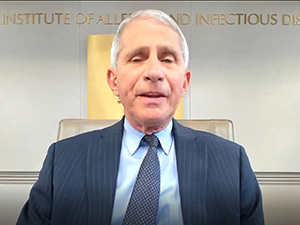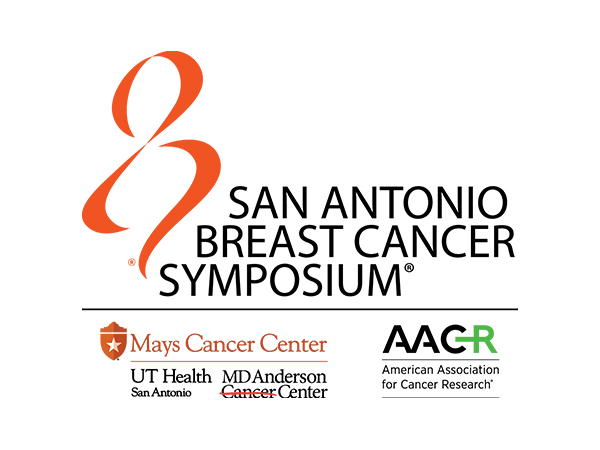AACR COVID-19 and Cancer Virtual Meeting: Dr. Fauci Launches Meeting with Keynote Address
The AACR Virtual Meeting: COVID-19 and Cancer opened Monday with a keynote address from the nation’s leading infectious disease expert, Anthony Fauci, MD, the director of the National Institutes of Allergy and Infectious Diseases. Well known for several decades in the realm of infectious diseases, Fauci has now become a household name in the United States due to his contributions in the response to the COVID-19 pandemic.
“Dr. Fauci is a renaissance man amongst physician-scientists,” said David Tuveson, MD, PhD, FAACR, program committee chair of the meeting and President-Elect of the AACR, in his introduction to Fauci’s presentation, adding that Fauci has devoted his entire 52-year career at the National Institutes of Health (NIH) to the understanding, prevention, and eradication of infectious diseases and autoimmune diseases. Fauci’s many career accomplishments include pivotal research discoveries, working with AIDS activists to introduce combination therapy for HIV patients, advising six successive United States presidents, and leading multiple national and international efforts against disease outbreaks, such as Ebola, tuberculosis, and now COVID-19. Fauci is a member of the President’s Task Force against COVID-19.
“His combination of scholarship, leadership, a tireless work ethic, and attention to detail have established Dr. Fauci as a beacon of knowledge and truth in our battle against COVID-19,” added Tuveson.
Fauci’s opening keynote address touched on several topics relating to the pandemic, laying a foundation for the sessions to come.
A Historical Perspective on Coronavirus Pandemics
Fauci began his talk with an overview of two previous pandemics: the severe acute respiratory syndrome (SARS) pandemic of 2002 and the Middle East respiratory virus (MERS) pandemic of 2012. Like the current COVID-19 pandemic, these pandemics were also caused by coronaviruses. Fauci explained that for many years, coronaviruses had been predominantly known for causing the common cold and that it was not until 2002—with the start of the SARS pandemic—that the potential for these viruses to cause pandemics became apparent.

SARS was first observed in November 2002 in the Guangdong province of China after the causative virus—SARS-CoV-1—was transmitted from a bat to a civet cat and finally to a human. SARS began to spread throughout the world after an infected individual traveled to Hong Kong and transmitted the virus to 19 other people who were staying at the same hotel. The pandemic lasted from November 2002 to July 2003; during this time, over 8,000 individuals were infected, and close to 800 people died from the disease. Fauci noted that SARS-CoV-1 was only moderately transmissible; therefore, measures such as wearing masks, physical distancing, and quarantine resolved the pandemic relatively quickly. “In essence, the outbreak was controlled purely by public health measures, without any drugs and without any vaccines,” he stated.
In 2012, the MERS pandemic began after the MERS coronavirus was transmitted from a bat to a camel and then to a human in Saudi Arabia. Since the onset of the pandemic, MERS has been diagnosed in more than 2,500 people and has caused 866 deaths, for an approximately 35 percent fatality rate. While the spread of MERS has slowed substantially, it continues to be observed to this day.
No End in Sight: The COVID-19 Pandemic
Like the viruses that caused SARS and MERS, SARS-CoV-2, the virus that causes COVID-19, likely emerged from an animal host. Since COVID-19 was first observed in December 2019, over 13 million cases have been confirmed, over half a million people have died, and there is “essentially no end in sight,” Fauci summarized.
Clinical Manifestation of COVID-19
“The thing that I’ve been most impressed with [about SARS-CoV-2]—of all the viruses that I’ve been dealing with over the last several decades—is the extraordinarily wide spectrum of disease,” Fauci noted. He explained that the disease can range from asymptomatic (in approximately 20 to 45 percent of cases) to severe, although the majority of cases tend to be mild or moderate. Severe illness can manifest as acute respiratory distress syndrome, hyperinflammation, cardiac or kidney injury, neurologic disorders, stroke, and/or pulmonary embolism. In some children, COVID-19 may manifest as multisystem inflammatory syndrome, a condition in which multiple organs become inflamed.
It has been observed that older adults and individuals with certain underlying conditions are at greater risk of developing severe disease. Underlying conditions that are known to increase the risk of severe illness include obesity, type 2 diabetes, renal disease, sickle cell disease, serious heart conditions, and being immunocompromised. Other factors, such as pregnancy, asthma, hypertension, type 1 diabetes, HIV infection, and smoking, may increase the risk, but the evidence is not clear at this point. Furthermore, hospitalization rates are highest for individuals of certain races/ethnicities, including American Indian/Alaska Native, Black, and Hispanic/Latino.
Impact of COVID-19 on Cancer
The COVID-19 pandemic has also impacted other areas of medicine, including cancer. Fauci explained that the closures caused by the pandemic have led to disruptions in both cancer care and research, which may have long-term effects. He cited a recent editorial from National Cancer Institute Director Ned Sharpless, MD, that projected 10,000 additional deaths from breast and colorectal cancer over the next decade due to reductions in routine screenings for these cancers.
Advances in Treatment and Prevention
For the final portion of his presentation, Fauci summarized some of the latest advances in treating and preventing COVID-19. He explained that two investigational therapeutics, remdesivir and dexamethasone, showed efficacy in patients with COVID-19 in recent clinical trials. The phase III clinical trial for remdesivir, an anti-viral that has been shown to inhibit the SARS and MERS coronaviruses, was the first randomized placebo-controlled study for COVID-19. The trial included 1,063 patients from 10 countries and found that hospitalized patients who were treated with remdesivir had a 32 percent faster recovery time, which Fauci described as a “modest but definite decrease in time to recovery.”
The RECOVERY trial examined the effect of dexamethasone, an anti-inflammatory agent, on patients with COVID-19. The trial included 6,425 patients in the United Kingdom, who were randomized to receive either dexamethasone in addition to standard care or to receive standard care alone. Dexamethasone was found to reduce mortality by 35 percent in patients who were ventilated and by 20 percent in those who were receiving oxygen. However, there was no benefit for patients who did not require any respiratory support, and results suggested that dexamethasone may have even had a negative effect for some of these patients. Fauci explained that the differing results between patients with early and advanced disease were consistent with the known pathogenesis of COVID-19. “Early on, you want to block the virus, but you want to keep the inflammatory and immunological response intact,” he said. “Later in the disease, when it becomes more advanced, you don’t have that much viral activity perhaps, but you certainly have a lot of aberrant inflammatory response [that] you want to damp down.”
Treatment guidelines continue to evolve as research provides new insight into the disease. To aid clinicians, the NIH has generated a live document of COVID-19 treatment guidelines. The page is updated regularly as guidelines shift in response to new advances.
Another key facet to addressing the COVID-19 pandemic is prevention through public health measures and vaccination. The NIH is supporting the testing of multiple vaccine candidates, including those that utilize DNA or RNA, viral vectors, or protein subunits as the vaccine platform. The NIH has tried to standardize the evaluation of these vaccine candidates with common protocols, data and safety monitoring boards, and primary and secondary endpoints. At the moment, the vaccine candidate produced by Moderna, which uses an mRNA platform, is the farthest along in the process and will be initiating a phase III clinical trial at the end of this month. Fauci noted that data from the phase I trial of this vaccine candidate demonstrated that even a moderate dose induced robust immune activity that was at the same or higher level as would be seen with convalescent serum.
For now, preventive measures such as washing hands, wearing a mask, and social distancing are important to slow the spread of COVID-19. “The bottom-line common denominator is physical distancing,” stressed Fauci, adding that this can be accomplished through stay-at-home orders, school and business closures, bans on public gatherings, aggressive case identification and isolation, and contact tracing and quarantine.
Looking beyond COVID-19
While COVID-19 has shaken much of the world, it is not the first pandemic to do so, and it will likely not be the last. As Fauci concluded his address, he emphasized the importance of being prepared for future emerging diseases. “We’ve always had emerging infectious diseases. We have them now, and we will continue to have them in the future. Just as emerging infections provide for us a perpetual challenge, we need to be perpetually prepared.”



